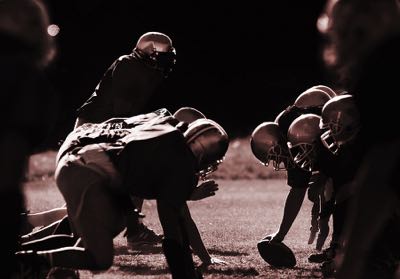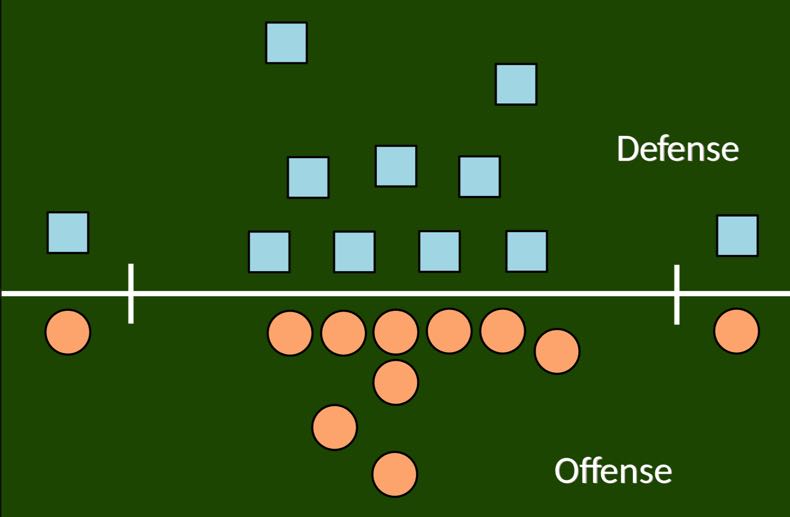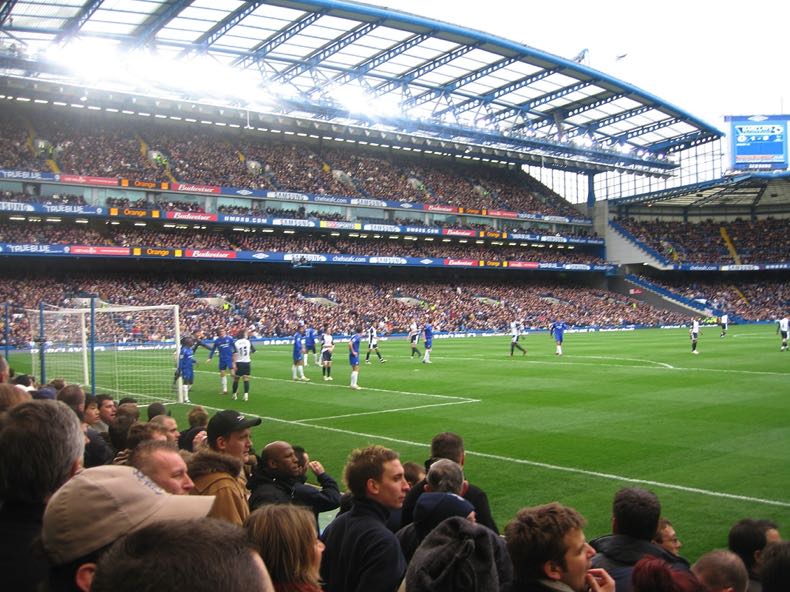 Watching a game of American football can be a confusing pastime for a good number of reasons. The myriad rules and regulations, the seven on-field officials and the yellow penalty flags flying left, right and centre. But even more confusing for many is the fact that the teams appear to rotate their players almost as soon as a play has concluded, with a completely different set of personnel on the field depending on whether a side is attacking or defending … or using their special team! So, the question is, how many players should be on the pitch for each side in an NFL match? And, how many players can a team call upon during a game?
Watching a game of American football can be a confusing pastime for a good number of reasons. The myriad rules and regulations, the seven on-field officials and the yellow penalty flags flying left, right and centre. But even more confusing for many is the fact that the teams appear to rotate their players almost as soon as a play has concluded, with a completely different set of personnel on the field depending on whether a side is attacking or defending … or using their special team! So, the question is, how many players should be on the pitch for each side in an NFL match? And, how many players can a team call upon during a game?
In this article, we’ll answer these questions and more, with a focus on the National Football League (NFL), the league at the pinnacle of the professional game. We’ll investigate how many players an NFL team has on the field, in the matchday squad and on their overall roster. We’ll also take a look at the many playing positions that exist in the sport and we’ll compare team sizes with some of the other most popular team sports from around the world.
Players in an NFL Team
 To keep things both simple and official, we will quote the NFL Rulebook which states: “The game is played by two teams of 11 players each.” It goes on to explain that if a team has more than 11 players on the field, it is a foul and a penalty is awarded to the other side. That’s all very clear then, but why are so many different players allowed to feature in an NFL match and how many players are there in the team roster (squad)?
To keep things both simple and official, we will quote the NFL Rulebook which states: “The game is played by two teams of 11 players each.” It goes on to explain that if a team has more than 11 players on the field, it is a foul and a penalty is awarded to the other side. That’s all very clear then, but why are so many different players allowed to feature in an NFL match and how many players are there in the team roster (squad)?
Unlike many other team sports such as soccer (or association football, if you prefer), American football has rolling substitutions. As such, a player who starts the game can be replaced but then later be reintroduced to the game. As long as substitutions are made when the ball is dead (out of play or between plays), players can be brought on and taken off as many times as the coaches like over the course of a game.
How Many Players on NFL Roster & Game-Day Roster?
Until recently, NFL teams were permitted to have up to 53 players on their roster, of which 46 could be dressed to play on a given game-day (and hence the game-day roster limit was 46 players). However, a new NFL Collective Bargaining Agreement (CBA) was agreed to in 2020 (that will run until 2030). This new CBA agreement increases the game-day roster to 48 players, as long as at least eight of the players are offensive linemen (see playing positions below). If fewer than eight of the players are offensive linemen, the game-day roster limit is 47 players.
Note that the overall roster size has also been increased from 53 to 55 players by allowing players from the practice squad to be added to the main roster, though – confusingly – this can only happen for a maximum of two games over the course of a season for any given player, and even then they must be moved into the main roster by 4 pm Eastern Time on the day before the game in which they may feature. If they are to feature for a third game, they must be added to the main roster full-time with an NFL contract (as opposed to a practice-squad contract).
So, in summary, an NFL team has 11 players on the field at any one time, up to 48 in the game-day roster and up to 55 in the main roster. Easy!
Playing Positions in NFL Teams

A diagram of a typical pre-snap formation (Killervogel5 / Wikipedia.org)
Now we’ve got to grips with the numbers, let’s turn our attention to the various playing positions in NFL teams. These can be split into three categories: offense, defense and special teams, with these being three separate units that take the field together depending on the state of the game.
Note that players in NFL matches must wear numbers on their jerseys that correspond to the positions they are playing. If a player changes positions during their career, they must be issued with a new number/jersey that corresponds with their new position.
Playing Positions – Offense
Let’s start with the attacking positions, which are broadly split in two: the offensive interior line (center, offensive guard, offensive tackle) and the backs and receivers (quarterback, running back, wide receiver, tight end).
- Quarterback – Considered by many to be the most important player on the field, the quarterback receives the ball from the center at the start of a play and passes or runs the ball or hands it off to a teammate, all with a view to making progress towards the opposing side’s end zone.
- Running Back – Running backs are the players who are the main rushing options to whom the quarterback can hand-off the ball to set up a rushing play.
- Wide Receiver – These players are the specialist catchers of passes and they aim to find space away from opponents so they are open to receive a pass from the quarterback, ideally in the end zone to score a touchdown.
- Tight End – Something of a hybrid, tight ends are similar to both offensive linesmen and wide receivers as they both block, or catch passes, depending on how a play goes.
- Center – The center snaps the ball to the quarterback to start the play and he, unsurprisingly, is (almost always) located in the middle of the offensive line.
- Offensive Guard – There’s an offensive guard on each side of the center and they are tasked with blocking the opposition players who may be trying to sack the quarterback or tackle someone on a rushing play. These are typically among the heaviest players on a side.
- Offensive Tackle – Positioned outside of the offensive guards, the tackles are also blockers who try to ensure the defending players can’t get past them to disrupt the offensive play.
Playing Positions – Defense
The defensive positions are split into three: defensive line (defensive tackle, defensive end), linebackers (middle linebacker, outside linebacker), and defensive backs (cornerback, safety, nickleback/dimeback).
- Defensive Tackle – Also known as a defensive guard by some, the defensive tackles are tasked with stopping passing or running plays through the middle of the action.
- Defensive End – Positioned outside of the defensive tackles, the defensive ends attempt to stop the passer making their pass and to stop any rushing plays in their vicinity.
- Linebackers – Positioned behind the main defensive line, the linebackers (which are split into middle linebacker and outside linebacker) have various duties but all revolve around stopping the opposition making effective plays.
- Defensive Backs – Defensive backs are generally tasked with stopping passing plays or running plays that have broken through earlier lines of defense. The cornerbacks try to intercept passes, the safeties are the last-ditch defenders and the nickelbacks or dimebacks are extra backs used in certain defensive formations to bolster the resistance of the defending team.
Playing Positions – Special Teams
Here are the main specialist positions in an NFL team. These players are usually brought on to perform a specific job at a particular time in the game or for a particular (usually less common) type of play. Special teams, ST for short, typically deal with attacking and defending field goals, punts, points after and kickoffs.
- Kicker – Unsurprisingly, the kicker – aka placekicker – is called upon to take kicks for field goals, extra points or kickoffs, although some teams have kickoff specialists who are only ever used for that duty.
- Punter – Another specialist kicker, but punters catch the ball from the snap then kick it from their hands (as opposed to field goals and so on which are kicked from the ground).
- Holder – A rather simple, if crucial, role here: the hold catches the ball from the snap and holds it for the kicker to kick for goal. The holder often has other strings to his bow and can act as a reserve for a player in a different position (often the quarterback) in case there’s an injury to the players who’s ahead of them in the pecking order.
- Long Snapper – Similar to the standard center as described above, but the long snapper is utilised to snap the ball to the aforementioned holder or punter, who would ordinarily stand further back than a quarterback would.
- Returners – The primary task of a returner is to catch the ball from the kickoff or after a punt and to run it back as far as possible towards the opposition side’s end zone. Returners are often reserve running backs, wide receivers or cornerbacks.
- Gunner – Utilised when their own team is kicking off or punting, the gunner’s task is to sprint down the field with a view to tackling the returner before they have made up too much ground.
How Does American Football Compare to Others Sports?

Chelsea vs Tottenham – Premier League Football/Soccer (inkiboo / Wikipedia.org)
There are many popular team sports that are enjoyed by players and fans around the world. Here we look at some of the most popular and how they compare to American football in terms of how many players are in a team (on the field of play).
| Sport | Number of Players in a Team | Example Leagues or Competitions |
|---|---|---|
| Rugby Union | 15 | Rugby World Cup, Six Nations Championship |
| Rugby League | 13 | Rugby League World Cup, National Rugby League (Australia/New Zealand), Super League (UK) |
| Soccer (Association Football) | 11 | Premier League, World Cup, Champions League |
| Basketball | 5 | National Basketball Association (NBA), FIBA Basketball World Cup, Olympic Games |
| Baseball | 9 | Major League Baseball (MLB), World Series, World Baseball Classic |
| Cricket | 11 | The Ashes, Cricket World Cup, Indian Premier League (IPL), T20 World Cup |
| Field Hockey | 11 | Hockey World Cup, Olympic Games |
| Volleyball | 6 | FIVB Volleyball World Championship, Volleyball Nations League, Olympic Games |
| Ice Hockey | 6 | National Hockey League (NHL), Winter Olympics |
As you can see, the 11 players allowed on the field for either team in American football is the same as for a soccer team, a cricket team or a field hockey team. Of the more popular team sports, only rugby league (13) and rugby union (15) have more players on a team than American football. However, given a standard American football team is essentially made up of three separate teams (offense, defense and ST) rolled into one, plus has a huge squad due to rolling subs, it is probably safe to say they have the biggest active team of any major sport.
